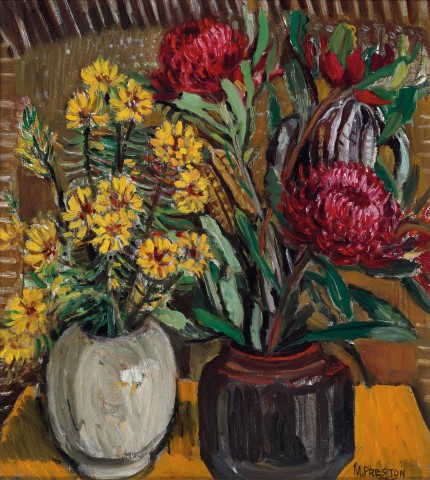WARATAHS AND PULTENAEA, 1955
MARGARET PRESTON
oil on canvas
50.0 x 45.0 cm
signed and dated lower right: M. PRESTON / 55
Private collection, South Australia
John Martin Gallery, Adelaide
Private collection
Joseph Brown Gallery, Melbourne
Private collection, Victoria, acquired from the above in December 1983
Exhibition of Past Australian Painters Lent From Private South Australian Collections, Adelaide Festival of Arts, John Martin & Co. Limited, Adelaide, 8 – 29 March 1974, cat. 91 (label attached verso, as 'Pultinea and Waratah')
For much of the twentieth century, Margaret Preston was a prominent and passionate advocate for a distinctly Australian form of modernism, one distanced from its European origins and synthesised instead through a fusion of Indigenous and Asian art. Her imagery, particularly when depicting Australian flora, has become embedded in the national consciousness with the result that her artworks are some of the most recognisable in this country. In 1953, Preston held her last solo exhibition at the Macquarie Galleries in Sydney. Opened by historian Bernard Smith, it was, she proclaimed, her final one ‘before the pearly gates.’1 However, she did not cease painting and two years later, created a powerful suite of still lifes harking back to her images of the 1920s, of which Waratahs and Wildflowers, 1955, is an excellent example from the sequence.
Preston’s passion for Australian native flora was such that it is somewhat surprising how rarely the waratah appears in her work, given that it is the State emblem for New South Wales. Apart from a handful of prints, she usually used the scarlet bloom as an accent within other mixed still lifes, making Waratahs and Wildflowers, 1955, significant for its painterly focus. Here, the clutch of waratahs is balanced by a bunch of yellow Pultenaea stipularis (commonly known as handsome bush-pea), each lot in their own vase, drawn from the artist’s personal collection of ceramics (both vases also appear in other Preston paintings from that year).2 Waratahs and Wildflowers was painted at Preston’s home studio in Killarney Street, Mosman, and she sourced the native flowers ‘from florists, or was given specimens by her friend T. G. B. Osborn, Professor of Botany at Sydney University.’3 Set upon a plain timber table, the flowers have as their backdrop a bold pattern inspired by the artist’s extensive knowledge of Indigenous motifs and symbols. Executed in earth colours, this staging presents an ‘authenticity’ for the presentation as a whole. Preston had first advocated the fine art qualities of Indigenous art in an article for Art in Australia in 1925 and many more essays followed.4 She consulted with museum officials, organised exhibitions, travelled extensively to remote rock art shelters and lectured widely on the subject. Her acts of appropriation regarding the original artists and their artworks have been criticised, but Preston acted with integrity within her chosen boundaries and undeniably widened the appreciation for Indigenous art in Australia.
Of the remaining paintings from 1955, three are in public collections: Fish and Black boys, 1955 (Art Gallery of New South Wales); Native flowers of Western Australia, c.1955 (Art Gallery of Western Australia); and Banksia and native flowers, 1955 (Dunedin Public Gallery, New Zealand). A fourth, Flowers in a jug, 1955, was sold through Deutscher and Hackett in 2017 (Important Australian and International Art, 20 September 2017, lot. 4). Given that Preston was eighty years old in 1955, these late works form a powerful coda to her career and give substance to one critic’s comment from her solo show two years earlier that she was ‘obviously an artist whose brush gains in vitality, instead of losing it with the passage of time.’5
1. Margaret Preston, 1953, cited in Butler, R., The prints of Margaret Preston: a catalogue raisonné, Australian National Gallery, Canberra, 1987, p. 8
2. The ginger jar holding the waratahs also appears in Banksia, 1955 (Bonetti Collection) and Banksia and native flowers, 1955 (Dunedin Public Gallery), whilst the vase with the bush peas features in Christmas Bells, 1955 (private collection).
3. Butler, R., ibid., p. 18
4. Preston, M., ‘The Indigenous art of Australia’, Art in Australia, 3rd series, no. 11, March 1925, np.
5. The Daily Mirror, Sydney, 23 September 1953, p. 25
ANDREW GAYNOR
